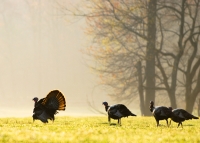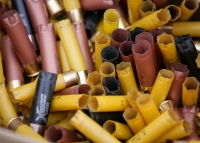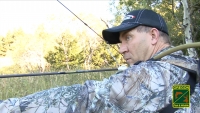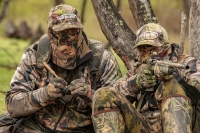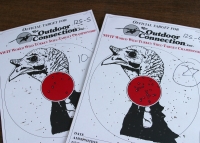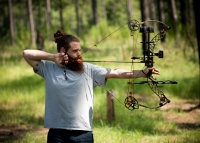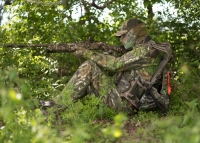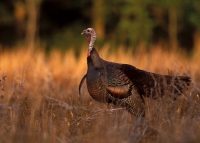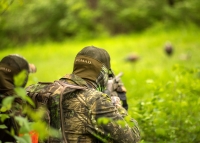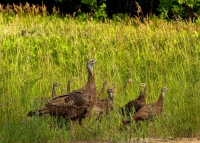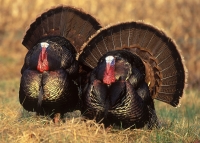
Calling turkeys
Sounds a turkey makes
Turkeys make a lot of different sounds, many of which are different in spring and fall. Though most hunters can routinely fill tags by using only two or three sounds, it’s good to know what other sounds turkeys make and why.
The hen yelp and variations
The most commonly heard sound in the turkey woods is made by the hen, and it’s called a yelp. Toms also yelp, but it’s louder, raspier and often more drawn-out than that of hens.
The yelp is usually delivered in a series of one-note tunes. However, yelps can take on various forms. Specifically, there are three types of yelps hunters will want to be aware of, each of which carries a different meaning.
Turkeys generally use a plain yelp when they are within sight of one another. It usually ranges from three to seven notes, but sometimes goes up to nine or ten notes. Three or four notes are made about a second apart, and the pitch and volume remain the same with each note. The sequence is simple, and resembles a chirp, chirp, chirp or a yup, yup, yup sound.
Birds use a lost yelp when they get separated from the flock, and it’s usually used by younger birds and hens with broods. Lost yelps are more intense than plain yelps. Lost yelps routinely consist of 20 or more notes, which also sets them apart from the more relaxed plain yelps. Lost yelps are more of a pleading sound that grows louder toward the end of each sequence.
Assembly yelps are even more intense. Assembly yelps bring back birds that separated from the flock. Assembly yelps are most common in the fall, when adult hens try to gather poults that have wondered off. Assembly yelps sound a lot like plain yelps, but are much more intense. They drag out and escalate in intensity, something like yuuup, yuuuuup, yuuuuuuup, yuuuuuuuup.
The cluck
The cluck is a basic turkey sound that carries a lot of meaning. Birds use the one to three note tuck...tuck,...tuck to get the attention of another bird, or to reassure an approaching tom that a hen is waiting for him. It’s an alluring, attention-grabbing sound that’s simple yet powerful when it comes to bringing in a tom. Hen clucks are a good call when a tom is hung up out of shooting range.
Many times when turkeys are feeding, clucks are made in conjunction with purrs.
The purr
Purrs are calming and reassuring. They send the simple message that birds are content and feel safe. Purrs are a soft, quiet sound that roll in a smooth, calming fashion. The purr is a single, drawn-out note that sounds like errrr.
Fighting purrs are longer and more frequent, often with a putt in the middle or at the end like errrrrrrrrr, errrrrrrrr, errrrrrrrrrrrrr, errrrrrrrrrrrr, putt, errrrrrrrr, putt, putt, errrrrrrrrrrrrr, errrrrrrrrr.
Clucks and purrs together send a message that all is safe and the birds are content, especially in a flock situation. A combination of clucks and purrs sounds something like tuck, tuck, errrrr.....tuck, errrrr...tuck, tuck, tuck, errrrr, tuck.
Cutts
Cutts, or cutting, are a series of loud, insistent, fast-paced, single-note sounds turkeys use when they’re excited, and are often used to elicit a response from another turkey. Cutting also sends a message that says “If you hear me and are ready to breed, you’ll need to come find me.”
It’s a very good call to bring in adult hens looking for a fight. Often the toms that are with them will come too. If a gobbler is henned up and the hen starts cutting, cut her off with the same sound. Often she’ll come in, bringing a tom with her.
A cutt is not an alarm sound, rather one of excitement and dominance.
Cutts are made in fast bursts of two or three notes, usually followed a second or two later by another burst. The sequence sounds like tut...tut....tut, tut, tut, tut...tut...tut...tut...tut, tut, tut, tut, tut.
The putt
Putts are a single alarm note to warn other birds of danger. A putt sounds exactly like it’s pronounced: putt! If you hear just a single note putt, putt!, don’t worry. But if you hear a series of putts -- putt, putt, putt!..putt! putt! putt! put! -- it means you’ve likely been busted.
The tree call
When birds are on the roost early in the morning, they create a series of soft, muffled yelps and clucks called a tree call. The tree call, or tree yelp, is simply the turkeys' way of talking among themselves.
The fly-down cackle
The fly-down cackle sounds like the cutt, with some clucks and yelps mixed in. When turkeys pitch out of the roost tree, they often call on their way down, thus the name fly-down cackle. The fly-down cackle consists of three to 10 crisp, loud sounds like tuck, tuck...tut, tut, tut, tut, tut, tut, tut, tut..tuck, yup. This is how turkeys communicate with and keep track of one another as they leave the roost. It’s a good call for hunters to use when a tom is still on the roost, as it sends a message that a hen has flown down and the tom should come find her.
The kee-kee
Of all the sounds turkeys make in the fall, the most commonly heard is the kee-kee. These are sounds made by young turkeys who’ve lost track of the flock and are looking to reassemble with adult birds. The kee-kee is usually made up of three fairly coarse and somewhat unevenly spaced kee, kee, kee sounds that last just over a second in length. As birds mature, the kee kee sounds become a bit raspier.
The gobble
There are few sounds in nature that capture attention like a turkey’s gobble. In the spring, toms gobble to let hens know where they are. Toms also express dominance through gobbling.
Spit & drum
Toms also spit and drum. The purpose of spitting and drumming is to attract hens, and it’s a difficult series of sounds for humans to hear. Spitting precedes drumming, and both sounds are unique and usually occur together like pffit, doooommmmmm.
Toms also yelp, cluck and purr, and these sounds are more evident in the fall than the spring. By listening to the array of sounds turkeys make, hunters learn about flock dynamics. Mimicking turkey sounds makes us better turkey callers, and therefore better turkey hunters.
Using a box call
A box calls is the most popular turkey call, and is a good choice for new turkey hunters. Box calls not only are easy to use, but they can sound very realistic.
A box call can create a wide range of yelps, clucks, purrs, fighting purrs, cackles and gobbles. If you can get yelps, clucks and purrs to sound good on a box call, you’ll routinely bring in birds.
Parts of a box call
Box calls come in two parts – a narrow rectangular box with a paddle attached at one end. Attached with a single screw in the center, the paddle can swing back and forth across the top of the box. It’s a kind of friction call where the sound produced depends on the pressure, speed and intensity of two surfaces rubbing together to produce sound. In the case of a box call, by rubbing the paddle across the top of the box.
Before you use your call, you’ll want to make sure the bottom of the paddle is coated with chalk or rosin. As you cover the underside of the paddle with chalk or rosin, you’ll notice it’s slightly curved. It’s this curvature of the paddle’s underside that creates different tones and pitches.
Take some time to experiment with your box call. Pass the paddle over both sides of the box to see what it sounds like. Usually one side sounds different than the other because of the thickness of the edges or the angle at which they’re cut. Higher pitched sounds usually come from the thinner side of the call; lower pitched from the thicker side. Many calls are intentionally made this way to produce a wide range of sounds.
To make yelps on a box call
Hold the bottom of the call in one hand between your thumb and fingers. With the other hand, pinch the handle between the thumb and index finger. With the center of the paddle about a 1/2-inch to the outside of one lip, lightly drag or scrape the paddle across the lip of the box. Stop dragging when the center of the paddle is about a 1/2-inch on the opposite side of the lip. This short, one-inch stroke is a yelp.
Apply three to five yelps in succession at the rate of about one per second, and you have a series of yelps. Try not to put too much pressure on the paddle or it won’t sound realistic.
To make a purr
Gently slide the paddle one to two inches across the lip. With some calls, the weight of the paddle is enough to generate a quality purr sound. Avoid putting too much pressure on the paddle.
To make a cluck
Quickly pluck the paddle over the lip in an upward motion. With the cluck, the paddle travels only about 1/4-inch, even less, over the lip. Think of creating a quick sharp popping sound with a quick tweak of the paddle off the lip. Use clucks at the end of a series of yelps, and softer clucks with purrs.
To make cutts
When locating toms, aggressive cutts are effective and simple to make with a box call. To make cutting sounds, apply pressure by pushing down on the paddle as you drag it across the lip. Quickly and aggressively, scrape the paddle over the lip, covering an inch or so with each pass. Making a dozen or so loud cutts is a great way to get toms fired-up and gobbling.
To make a cackle
Start with a few yelps, then progress into five or six cackles by quickly striking the lip with the center of the paddle. End the sequence with a few yelps and you have a very realistic sounding yelping and cackling sequence both toms and hens will respond to.
To make a gobble
The best gobbles from a box call come by securing the handle to the body of the call with a rubber band and shaking it back and forth. To make a gobble, hold the bottom of the call with the handle pointing upward. Vigorously shake the body of the call from side to side, sending the paddle into motion. Make sure there’s enough tension on the paddle that it aggressively scrapes the lip with each pass.
Caring for your box call
It’s important to keep the box call’s surface clean and dry while you’re in the field. Some turkey vests come with built-in pouches for carrying and protecting box calls. Some hunters simply carry them in plastic bags.
Some tips for keeping your box calls ready in the field:
- If your call gets dirty, wipe it clean with a rag. Any debris or moisture on the calling surfaces will affect sound quality.
- If you do have to wipe down your call, you may need to re-chalk the underside of the paddle. Use only chalks designed for turkey calls, or ones with no oil or sugar base. Carpenter's and billiards chalk work, too.
- When handling a box call, keep all fingers off the underside of the paddle and the beveled edges of the box. Nothing will render a box call useless faster than getting hand oils on the calling surfaces.
- When toting your box calls in the field, keep the paddle secured to the box with a rubber band. This will help keep the call quiet and prevent wear.
At season’s end, simply store your box calls in a holster or cloth bag in a dry place.
Using a pot call
Pot calls, often called slate calls, are friction-style calls that are easy to use and produce a range of turkey sounds.
Parts of a pot call
A pot call consists of three parts: a pot, a calling surface and a striker.
The pot holds the slate and acts as a sound chamber. There are holes drilled in the bottom for sound to escape. To keep from covering the holes, hold the pot with the tips of your fingers, keeping it away from the palm of your hand. Pot calls can be made to be all-weather, with the right striker.
The slate or calling surface can be made from actual slate, glass or other material. Each one will produce a slightly different sound. Actual rock slate is a popular, effective calling surface but it’s useless in the rain. In wet conditions, more common in spring, some hunters prefer a glass or aluminum calling surface.
Finally, the striker looks like a small wooden baton that you’ll hold like a pencil when you drag it across the slate. Strikers, too, come in a variety of materials, each producing a unique sound. Most quality pot calls come with one or two strikers to get you started.
Conditioning your pot call
Before you use a pot call for the first time, you’ll need to condition the calling surface. Conditioning is roughing up the surface with sand paper or other abrasive. This creates groves on the calling surface that the striker skips across to make a noise.
WARNING: When conditioning a calling surface, brush the sand paper across the slate in one direction only. That way when you run the striker across the surface, you’re going across the grain, creating realistic calls. Do not use a circular motion. Your call might skip or miss those times the striker runs with the grain.
Real slate is relatively soft, and can be conditioned with 200 grit sand paper or a Scotch Brite pad. For those harder surfaces like metal and glass, you’ll need to be a bit more aggressive and use something like 80 to 40 grit material.
You also can use 220 grit sandpaper to sand the tips of your strikers. The tip of the striker can get clogged with sediments from the slate’s surface, resulting on a poor sounding call. To clean the striker, drag the tip across the sandpaper in a single direction.
Making sounds
Now that your pot is conditioned and the striker clean, it’s time to make sounds.
Hold the striker about one-inch up from the bottom, like you would a pencil. Tip the top of the striker away from you, so it’s at a 45º angle when contacting the pot’s surface. This angle should remain constant throughout the calling process, no matter which sounds you’re making.
Also, you’ll want to find the sweet spot on each pot. Most pots sound best when the strikers are “scratched” across the surface about one-third of the way in from the outer edge of the pot. Some have sweet spots a little closer to center.
To make a yelp
Begin by holding the pot in one hand. Grip it around the outer edges with your extended thumb and index finger (or middle) finger. Place the tip of the striker on the pot and draw a small oval shape, about the size of a dime.
Keep the striker constant contact with the calling surface. Don’t lift it at the end of a call or when you’re pulling the striker away from the center.
A “yelp” is made when you push the striker down toward the center of the call, skipping it across the pot’s surface. When you drag the striker back to the starting point you won’t hear anything because the striker is now angled in the opposite direction and doesn’t “skip” over the grooves. Each time you move the striker downward, it yelps. Repeat making the oval three to five times about a second apart for a series of yelps.
Apply more or less pressure on the striker to get higher or lower pitched sounds. Higher pitch notes simulate young hens, while the raspy yelps of older hens and toms can be made by using less pressure with the striker.
To make a pleading or lost yelp, draw bigger ovals about the size of a quarter on the calling surface. This drawn-out yelp is great for calling in hens and hoping toms will follow.
To make a purr
Grip the striker about a half-inch higher from where you gripped it to make yelps. Exposing more of the striker will change the tone of the call. With light pressure, draw the tip of the striker toward you, from the outer edge of the slate to the middle. As you draw the striker, it will skip lightly across the slate’s surface in a straight line producing a purr. Practice this and the purr will become one of the easiest sounds to make on a slate call.
To create fighting purrs, simply pick up the pace of the purrs using the same motion. Grip the striker a bit lower down and apply more pressure and you’ll create a louder, sharper tone. Increase the frequency and urgency of this call and it will start to sound like an excited flock during flight.
To make a cluck
Grab the striker about a half-inch from the bottom and press down firmly while you pull in toward you. The peg should make a quick, sharp jump that creates a one-note sound. To get the cluck tone you want, move the striker around on the slate’s surface to find the sweet-spot.
To make a cutt
Make the same stroke as you would for a cluck, but longer. Quickly follow up with five or six more of the same stroke. Start each pull at the same point and return the striker quickly to the starting point to deliver the cutt calls in a fast sequence.
To make a cackle
Add some yelps and clucks to the front end of a cutting sequence and lessen the pressure during the cutting action. This is a great early morning call when working birds off a roost in both the spring and fall.
Caring for your pot call
To keep your pot call in good working condition, never touch the surface of the slate with your bare fingers or hands. Oils from your hands on the call’s surface can render it useless. Some pots come with a plastic lid that snaps over the top to protect the calling surface. Otherwise, put the pot in a plastic bag or storage pouch before putting it in your vest so it won’t rub against anything that might wear down the conditioned surface.
When storing pot calls and strikers, keep them in a cool, dry place to prevent warping and weathering due to exposure to the elements.
Using a mouth call
Mouth calls, also known as diaphragm calls, can seem intimidating but they have some advantages over other kinds of calls.
Mouth calls are popular with Oregon turkey hunters because:
- They're easier to keep dry during wet, spring seasons than are box or slate calls.
- Since the the call is in your mouth, you can call in a turkey without moving and possible spooking the bird.
- With practice, they can produce very realistic turkey sounds.
Parts of a mouth call
There are four parts to a mouth call. Starting at the outside of the call there’s:
The tape. The tape stops air from blowing around the reed, and flowing through it instead. The tape is usually made of a somewhat pliant material that can be trimmed to fit your mouth.
The frame. Usually made of rigid plastic or aluminum, the frame stretches and holds the reed in place.
The tab. The tab is at the back of the frame – the closed part of the call. It helps add tension the back of the reed and identifies which side of the call goes up or down. In most calls, the tab goes down when placing the call in your mouth.
The reed(s). A thin latex (or similar kind of rubber) membrane that vibrates as air passes under it, creating sounds you hope sound like a turkey. Some calls have multiple reeds for making multiple sounds.
Some reeds also have cuts along the exposed edge to help mimic different sounds.
Buying your first mouth call
If you’re buying your first turkey mouth call, here are a few things to consider:
- Start with a simple single-reed call with a straight-edge reed. These are the simplest mouth calls to master.
- Consider starting with a smaller call until you get accustomed to having a call in your mouth.
- Be glad that mouth calls are relatively inexpensive because you might need to try a couple to find the one that works best for you.
Using a mouth call
Start slow. Your initial goal is to simply make a sound, not to necessarily mimic a turkey. To generate a sound, it’s all about properly positioning the mouth call in the roof of your mouth.
Put the call in your mouth with the open edge facing forward. Use your tongue to position the call in the roof of your mouth, about half-way between your front and back teeth. On multi-reed calls, place the short reed down.
Experiment with where you put the call in your mouth. Move the reed forward or backward a bit until it feels the most comfortable. Also, feel free to trim the tape for a better fit in your mouth.
Place the top of your tongue against the tape, pinning the call to the roof of your mouth. The idea is to create a seal so no air passes over the top of the tape or around its edges. When blowing lightly, you want air moving over the top of your tongue, and beneath the call.
Air passing under the reeds causes them to vibrate, creating sound.
As you blow, your air should come from within your chest or diaphragm. Think of fogging up a pair of glasses or binoculars to clean them -- that’s where the air should come from. Don’t blow through your mouth as if you are blowing out a candle. Air should be forced from within your chest.
Making turkey sounds
To make a yelp
A hen help is the simplest, and should be the first, turkey sound you try to make with a mouth call. With the call in your mouth, press the reed lightly with your tongue, and blow while saying the word “yelp” or “chalk.”
At first it will likely tickle; that’s okay and normal. Experiment with call placement, tongue pressure and air flow until you produce quality sounds without tickling your mouth. Keep working on it until you get a soft yelp. Once you get a single yelp, work on producing a series of yelps.
To make a purr
There are two ways to produce a purr: by blowing and fluttering the lips, or by blowing and fluttering the tongue. Either way, the goal is to create a soft, short, non-threatening sound.
Purrs – like yelps and other sounds produced from a mouth call – can vary in volume based on how hard you blow, and in tone based on how much tongue pressure is applied.
To make a cluck
Create a cluck by expelling a short, sudden burst of air while saying the word “puck.” Build-up the air pressure in your diaphragm (chest), then quickly release it.
To end the call, quickly close your lips, cutting off the sound. The cluck is a short, quick note that’s used in combination with yelps and purrs. It’s a good call to try when a tom is hung up just out of shooting range.
To make a cutt
The cutt is nothing more than a hyped-up version of the cluck. To make cutting sounds, relax. The sounds are simply a drawn-out series of clucks made in succession. Rather than saying the word “puck” when you exhale, try saying “pick” or “peck” when cutting.
When cutting, the airflow is drawn-out longer than when clucking. Sounds are usually made in rhythmic groups of ones, twos, threes and fours. Think of Pick-PickPickPick – PickPickPickPick - PickPick. When making this call, be excited and loud. This can be a fun and rewarding sound to make with a diaphragm call, but it takes some practice to master.
To make kee-kee
Kee-kee calls work well in the fall season. Apply tongue pressure toward the front of the reed, narrow the air passage under your tongue and blow boldly while saying “kee-kee” or “tee-tee.” The result should be high-pitched kee-kee call.
Caring for your call
To keep your mouth call in good working order, you’ll need to care for it from day to day, and from season to season.
If not cleaned and stored properly, mouth calls can dry out, split and become useless. When carrying mouth calls afield, use leather or synthetic pouches that allow air to circulate around the calls. At the end of the day, rinse every mouth call you used in mouthwash to rid them of bacteria, then dry them off.
When the season ends, clean and dry your calls before storing them. At the start of each season, test each call. Make sure they produce crisp, clear notes, not muffled sounds with uncontrolled vibrations. If the sound quality is poor, it’s time to replace the call. To keep your mouth calls working effectively, take proper care of them.
Using a locator call
These calls have nothing to do with calling in turkeys, but everything to do with finding toms. Owl, crow, peacock, woodpecker and hawk sounds all can elicit a reactionary gobble from a tom – sometimes called a “shock gobble.” These calls are usually used when birds are on the roost early in the morning or late in the evening.
Using a hen call to locate a tom can put the tom on the move before you’re ready to set up. If a tom comes in too quickly, it can mean a blown opportunity.
Locator calls encourage toms to gobble without encouraging them to move towards you.
Types of locator calls
Carry a selection of locator calls in your vest, because toms won’t always respond to the same sounds.
- Owl hooter calls are one of the most popular locator calls. Owl calls aren’t very loud, so they’re most effective on calm mornings in open, flat country, or in timbered areas where turkeys are nearby.
- Crow calls are another popular locator call. Practice by listening to real crows in your neighborhood and trying to imitate their sounds.
- Hawk, peacock and even coyote calls also can be used to locate a tom. In the evening, a louder, more aggressive locator call often works best. This is when coyote and peacock calls seem to be most effective.
Using calls to find a turkey
Deliver locator calls in quick, short, loud bursts. Don’t drag out the calls. The goal is to create loud, crisp sounds that make a gobbler react.
If you’re hunting alone, it can be hard to hear a tom answer back. Especially if he does so early in your calling sequence. Therefore, keep your locater calls brief and loud, then be ready to listen. Once you’ve delivered your call, don’t move or shuffle. You don’t want to miss a faint, distant gobble that may mean the difference between filling a tag or not.
If you're hunting with a partner, have them stand 10 steps to the side of you where they might have a better chance of hearing a shock gobble from a tom.
Locator calls can save a lot of time by helping find toms you otherwise might have missed. Practice with these calls and be ready to make a game plan. When a tom gobbles back, you’ll want to move into position quickly.
Turkey sounds hunters should make
When it comes to calling turkeys in the spring, we’re being a bit unnatural. In the turkey woods, toms gather on strutting grounds and try to call hens to them. Hunters are doing just the opposite: making hen sounds to bring toms to them. For this reason, it pays to develop confident turkey calling skills.
Here’s a look at the turkey sounds hunters will want to be able to make. Refer to the instructions for each kind of call to see how to mimic these sounds.
The yelp is a basic turkey call and the easiest sound to make. It’s also the one that will bring in the most toms and hens during both the spring and fall seasons. The yelp calling sequence is a simple yup, yup, yup. The purpose is to send the message that all is safe and to let other turkeys know their location. This is a good call to use when trying to bring birds in close.
Blow three to five yelps in succession at the rate of about one per second, and you have a series of yelps.
The cluck is a simple, alluring sound that’s effective for bringing in a tom. Clucks are made up of one to three single, staccato notes, usually separated by two to three seconds. The sharp, crisp sounds of a cluck are mainly used in close range calling situations. When an approaching tom hangs up in sight of your setup, a cluck will often pull him the rest of the way in.
Clucks are good to use at the end of a series of yelps and, when made softly, pair well with purrs.
Purrs are a relaxing, reassuring calls that send the message all is safe. Purrs are soft sounds that roll in a smooth, calming fashion, like errrr. They are not very loud. This is a great call to offer when toms are close, especially if they seem nervous.
Tree calls, or tree yelps, are a wake-up calls to the rest of the birds in the area and mark the start of a new day. They’re useful in both spring and fall. Sometimes tree yelps start an hour before turkeys actually fly out of the roost.
A tree call is a softer, slightly more drawn-out versions of the yelp. Mimicking the sounds of turkeys on the roost is the best way to learn and master this call.
In the fall, turkey hunters will want to use the kee-kee call. This mimics the sound young turkeys make when they’ve lost track of the flock and want to reassemble with adult birds. This is a very common call heard from August through February. The key to making this call work is sticking with a three note sequence, kee, kee, kee. Avoid the temptation to extend the call to five or six notes even if sounds good.
While turkeys, and hunters, can make other turkey sounds (gobbles, putts, fly-down cackles, and more), yelps, clucks, purrs and tree calls will account for most of your calling. And they’ll consistently yield results.

